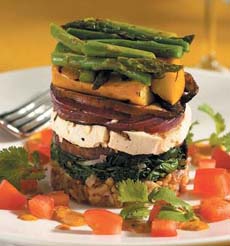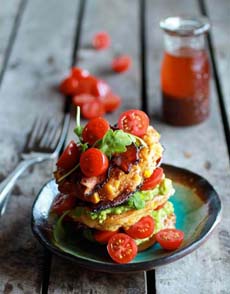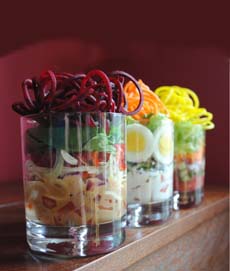


[1] Stacked vegetables as short or tall as you like (photo courtesy Citrine World Bistro, late of Redwood City). [2] Stack polenta or fritters, like these from Like It Short (website no longer up). [3] If you don’t want to deal with ring molds, stack your veggies in rocks glasses (photo courtesy The Whole Gang.
|
|
These look fancy, don’t they?
But you can easily make vegetable stacks at home, even with leftovers.
While many people currently are focused on stacked salads in mason jars, we’re freeing the veggies from the jar today, and serving them cooked as well as raw. Even those who don’t like their vegetables will be happy.
Serve stacked veggies as a first course, with the cheese course. You can add wedges of cheese to the plate, or slice layers into the stack (blue, brie, chèvre, feta, mozzarella, etc).
Serve them as a luncheon or dinner salad with a layer of protein (chicken, fish, protein salads [egg, crab, tuna, etc.], tartare, tofu, veggie burgers, etc.)
HOW TO STACK THE VEGETABLES
In ring molds. You want 3-4 inch rings, as tall as you can find so they can be used for short and tall stacks.
In rocks glasses.
In repurposed food cans, tops and bottoms removed*.
In lengths of PVC† plumbing pipes, cut to order at the hardware store.
________________
*Don’t worry about PVC leaching into your food. You’re not cooking/heating the rings, and you’re only using them for a couple of minutes to assemble, as opposed to plastic bottles that can hold water for months or years.
†One of the problems with using the time-honored empty can for stacking is that many cans now have “formed” bottoms that stack more easily, but can’t be removed with a can opener. So don’t throw away expired canned food without checking to see if you can use the empty can! Also, look for the older can bottoms with foods from Mexico and Asia, from packing plants that still use the old technology.
RECIPE: VEGETABLE STACKS
Ingredients
Ingredients can be whatever you want or already have, and in whatever form: cooked, puréed, raw.
Be sure to vary the colors (you don’t want a stack of beige ingredients) and include pops of color.
Canned: beets, corn, water chestnuts
Color: red, yellow or orange bell peppers, tomatoes and all of these
Eggs: hard-cooked or Japanese omelet (tamago)
Fruit: sliced or diced (apple, mango, pineapple, etc.)
Garnishes: fresh herbs (try a dill or rosemary plume), chip, spiraled beets
Grains and starches: polenta slices, potato (diced, mashed, sliced), rice, quinoa, etc.
Greens: arugula, avocado, cress, spinach, spinach, zucchini, etc.
Plate garnish: chopped nuts, infused olive oil, seeds, microgreens
Sides: gourmet chips or crackers, toasted baguette slices
Pinterest has a page of lovely stacked vegetable ideas.
|
For The Dressing
You need just a light sauce on the side: ramekins of balsamic vinegar, a vinaigrette, infused oil‡ or a vegetable oil blended with dark sesame oil (a little goes a long way).
Also consider dipping sauces from Asia, such as chili sauce or ponzu. Both can be purchased or made at home.
We also love a yuzu vinaigrette.
Preparation
1. CHOOSE your ingredients. Try for contrasting colors and plan your layers. Stack heavier items at the bottom.
2. SPRAY the inside of the molds, if using, so the food slides out more easily.
3. SET each stack on a serving plate, and garnish the plate with droplets of olive oil (especially flavored oil!).
________________
‡A delicious alternative to a vinaigrette, infused oils are available in a score of flavors: basil, blood orange, chile (ancho, habanero, jalapeño), dill, garlic, Meyer lemon, lemon pepper, oregano, rosemary, truffle, scallion, wasabi, etc.
|





